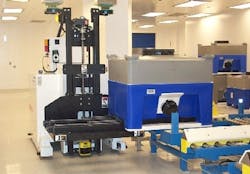By Paul Thomas, Managing EditorEven before it restarted production in 2004, Apotex, Inc.s Etobicoke, Ont., facility garnered plenty of attention as a showcase for innovative plant design and automation (Pharmaceutical Manufacturing, January 2004, p. 47).The facility, following a $238 million expansion, is a multilevel symphony of automated lifts, conveyers and automatic guided vehicles (AGVs) that move product from storage to production suites to warehouses at the behest of the plants execution system. Radio frequency identification tags and barcodes keep track of bins, totes and other assorted containers and relay batch and product weight information to the system.When he was put in charge of logistics for the new site, project leader Chip Hill knew it was a rare opportunity. We got the signal from upper management to automate as much as possible, but few details on how, Hill says. We had to fill in the blanks.A new Yield Check system filled one of these blanks. Hill and Dave Patterson, VP of Grantek Systems Integration, Inc. (Burlington, Ont.), the lead systems integrator on the expansion project, linked a network of calibrated load cells to a database, to monitor and optimize weighing and provide redundant information regarding in-process totes and bins.Since operators rarely enter the processing suite, the Yield Check system eight scales for bins, and eight for totes is really the only way operators have of knowing how much product is in the containers, and thus where they belong at any moment.Carrying the weightThe key consideration for choosing weighing equipment was its ability to integrate with the Allen-Bradley PLC architecture supporting the plants operations. Apotex chose equipment from Hardy Instruments (San Diego, Calif.), an AB Encompass partner whose weigh-scale cards fit directly into the buses of PLCs. No wiring was involved.This was a huge advantage for implementation and maintenance, Hill says. If we had a load cell or PLC go down in the field, we wanted to make sure a technician could replace it without much effort and not interfere with operations, he says.Hardy also offered electric, push-button C2 scale calibration that eliminated the need for cumbersome test weights. Load-cell data are recorded on a database, so that operators dont have to calibrate each occasion from scratch.Hardys Integrated Technician was also a key reason the technology was chosen, says Gene Chae, senior developer at Grantek. This feature allows operators to check scales upon demand to, for instance, check millivolts, excitation or resistance on each load cell at any given time.The implementation also required some customization. Hardys load cells had to be specially designed to accommodate robots that are anything but delicate and that also vibrate bins to remove product. Dropping a 4500-pound bin at so many feet per second isnt a gentle process, says Alan Davis, president of CTH Industrial Controls, the equipment provider. Shock-absorbing load cells were built with rubber, disc-shaped grommets between cells and mounting plates.A real-time link to ERPWeigh-scale data are event-driven and gathered by the PLCs, which are linked to the companys secure VPN, or virtual private network, using a system designed by Granteks SAP interface team, then transferred to a Rockwell RSView database for plant-floor viewing.Granteks SAP interface team also worked with SAP to provide real-time integration of load cell data with the back end of the Apotex ERP, allowing for constant production monitoring and materials management. Through an HMI, an operator can push a button and trigger a materials update or initiate batch production.The advanced automation at Etobicoke hasnt replaced operators altogether, but has required them to step up their performance. Theyve really had to learn to understand what the building is supposed to do, Hill says. Its a big monster, and its parts all work together.
Latest from Automation & Control
Latest from Automation & Control







